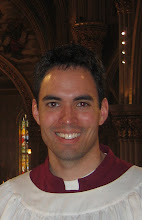 Hymnody and Psalmody
Hymnody and Psalmody(Hymn Title - TUNE NAME)
At That First Eucharist - UNDE ET MEMORES
Psalm 116 - Michael Guimont
Zion, Praise thy Savior - ALLES IST AN GOTTES SEGEN
Shepherd of Souls, Refresh and Bless - ST. AGNES
See Us, Lord about Your Altar - DRAKES BOUGHTON
Sequence for Corpus ChristiThe Hymn at the Sequence for this weekend has been translated into English from the original Latin and set to a chorale tune. The text
Lauda Sion Salvatorem is a prose text that offers liturgical reflection proper to this solemnity.
For more information, Dr. Patrick Gorman, Director of the Madison Diocesan Office of Worship, has written a very helpful article, which can be read at
One Body, One Spirit.
Musical Notes for Corpus ChristiThe postlude for the Solemnity of the Most Holy Body and Blood of Christ is a chorale prelude on
Schücke dich ("Deck thyself, my soul, with gladness"). This composition is an example of the long-standing organ tradition of arranging popular hymn tunes with creative harmonizations to serve as introductions. The hymn tune
Schmücke dich is commonly sung with the following Eucharistic text:
Deck thyself, my soul, with gladness,
Leave the gloomy haunts of sadness;
Come into the daylight’s splendor,
There with joy thy praises render
Unto Christ Whose grace unbounded
Hath this wondrous banquet founded.
Higher o’er all the heav’ns He reigneth,
Yet to dwell with thee He deigneth.
Hasten as a bride to meet Him
And with loving reverence greet Him;
For with words of life immortal
Now He knocketh at thy portal.
Haste to ope the gates before Him,
Saying, while thou dost adore Him,
Suffer, Lord, that I receive Thee,
And I nevermore will leave Thee.
He who craves a precious treasure
Neither cost nor pain will measure;
But the priceless gifts of heaven
God to us hath freely given.
Though the wealth of earth were offered,
Naught would buy the gifts here offered:
Christ’s true body, for thee riven,
And His blood, for thee once given.
Ah, how hungers all my spirit
For the love I do not merit!
Oft have I, with sighs fast thronging,
Thought upon this food with longing,
In the battle well nigh worsted,
For this cup of life have thirsted,
For the Friend Who here invites us
And to God Himself unites us.
In my heart I find ascending
Holy awe, with rapture blending,
As this mystery I ponder,
Filling all my soul with wonder,
Bearing witness at this hour
Of the greatness of God’s power;
Far beyond all human telling
Is the power within Him dwelling.
Human reason, though it ponder,
Cannot fathom this great wonder
That Christ’s body e’er remaineth
Though it countless souls sustaineth
And that He His blood is giving
With the wine we are receiving.
These great mysteries unsounded
Are by God alone expounded.
Sun, who all my life dost brighten,
Light, who dost my soul enlighten;
Joy the best that any knoweth;
Fount, whence all my being floweth;
At Thy feet I cry, my Maker,
Let me be a fit partaker
Of this blessèd food from heaven,
For our good, Thy glory, given.
Lord, by love and mercy driven
Thou hast left Thy throne in heaven
On the cross for me to languish
And to die in bitter anguish,
To forego all joy and gladness
And to shed Thy blood in sadness.
By this blood redeemed and living,
Lord, I praise Thee with thanksgiving.
Jesus, Bread of Life, I pray Thee,
Let me gladly here obey Thee.
By Thy love I am invited,
Be Thy love with love requited;
From this supper let me measure,
Lord, how vast and deep love’s treasure.
Through the gifts Thou here dost give me
As Thy guest in heaven receive me.









